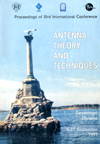Estimation of the influence of receiving-amplifying sections non-linearity on the adaptive antenna arrays efficiency
DOI:
https://doi.org/10.1109/ICATT.1999.1236189Abstract
The adaptive antenna arrays (AAA) still remain one of the most effective means of concentrated interference control, for when applying them there is no need to change regimes of radio lines, whereas a level of interference suppression attains tens of dB [1–3].
In the same time, a number of authors [1, 3] point to the AAA efficiency sharp loss due to non-linearity in receiving sections.
References
Rodimov, A.P.; Popovsky, V.V. Statistical Theory of Polarization-Temporal Signal and Interference Processing. Moscow: Radio i Svyaz', 1984, 272 p. [in Russian].
Grishin, V.K.; Zhivopistsev, F.A.; Ivanov, V.A. Physical Experiment Mathematical Processing and Interpretation. Moscow: Isd-vo Moskovskogo Universiteta, 1988, 318 p. [in Russian].
Levin, A.R. Theoretical Foundations of Statistical Radio Engineering, 3rd ed. Moscow: Radio i Svyaz', 1989, 656 p. [in Russian].
Tikhonov, V.I. Statistical Radio Engineering. Moscow: Radio i Svyaz', 1982, 623 p. [in Russian].
Kоlyadenko, Yu.Yu. Non-linear stochastic model of telecommunications signal spatial-time processing. Radiotetekhnika, 1999, No. 109.
Shooster, G. Deterministic Chaos: Introduction. Moscow: Mir, 1988, 240 p. [in Russian, transl. from English].

